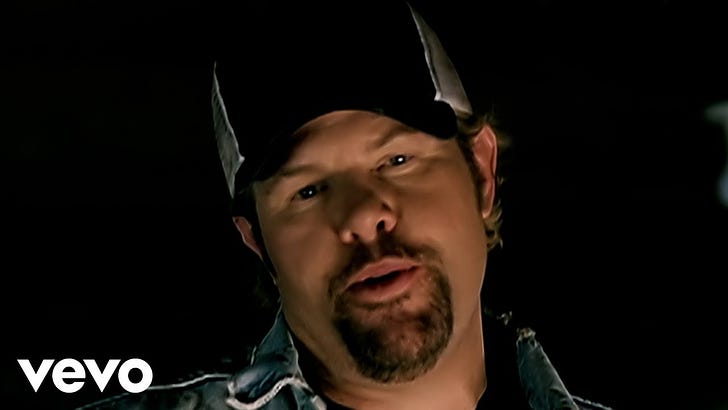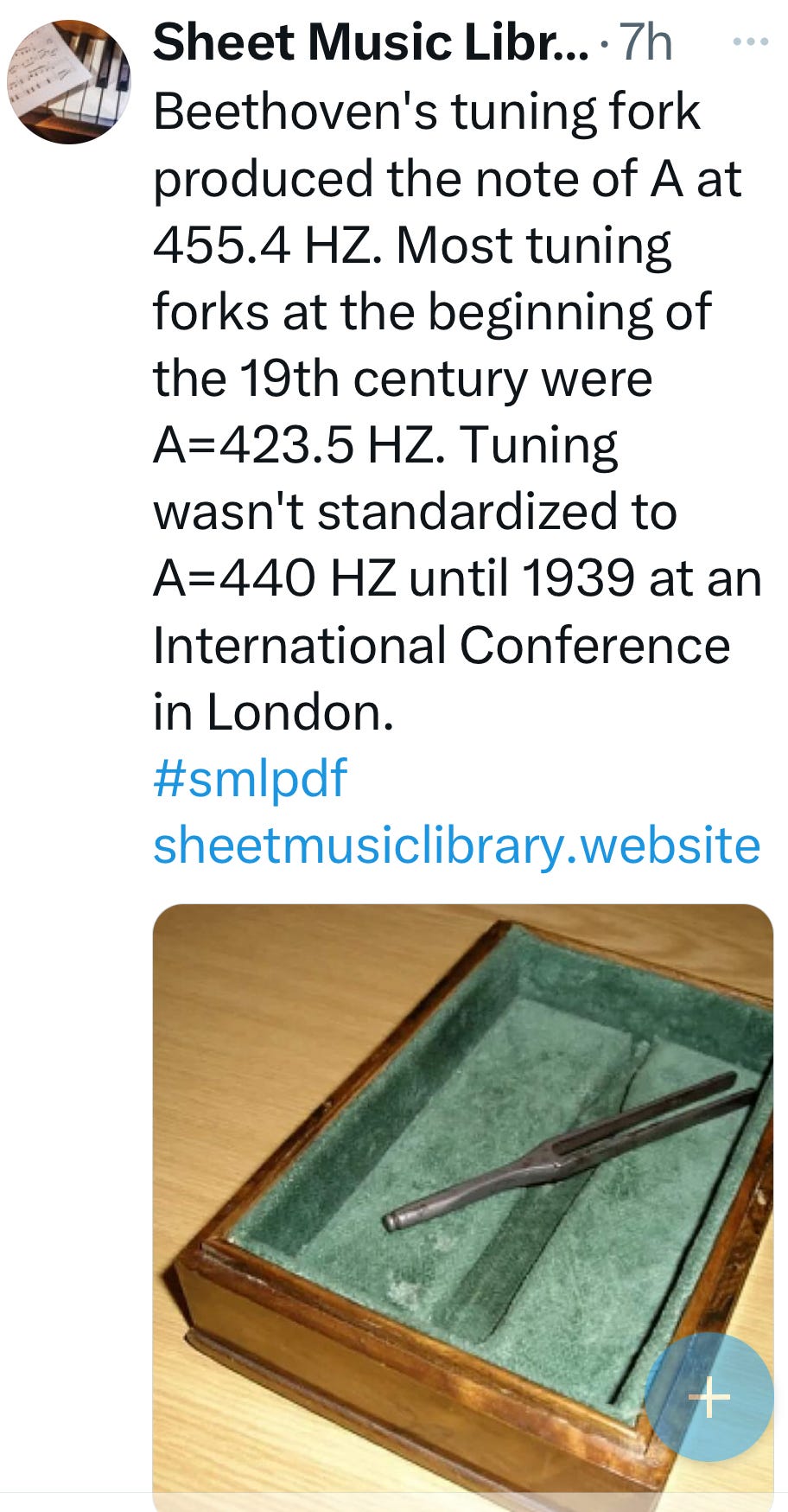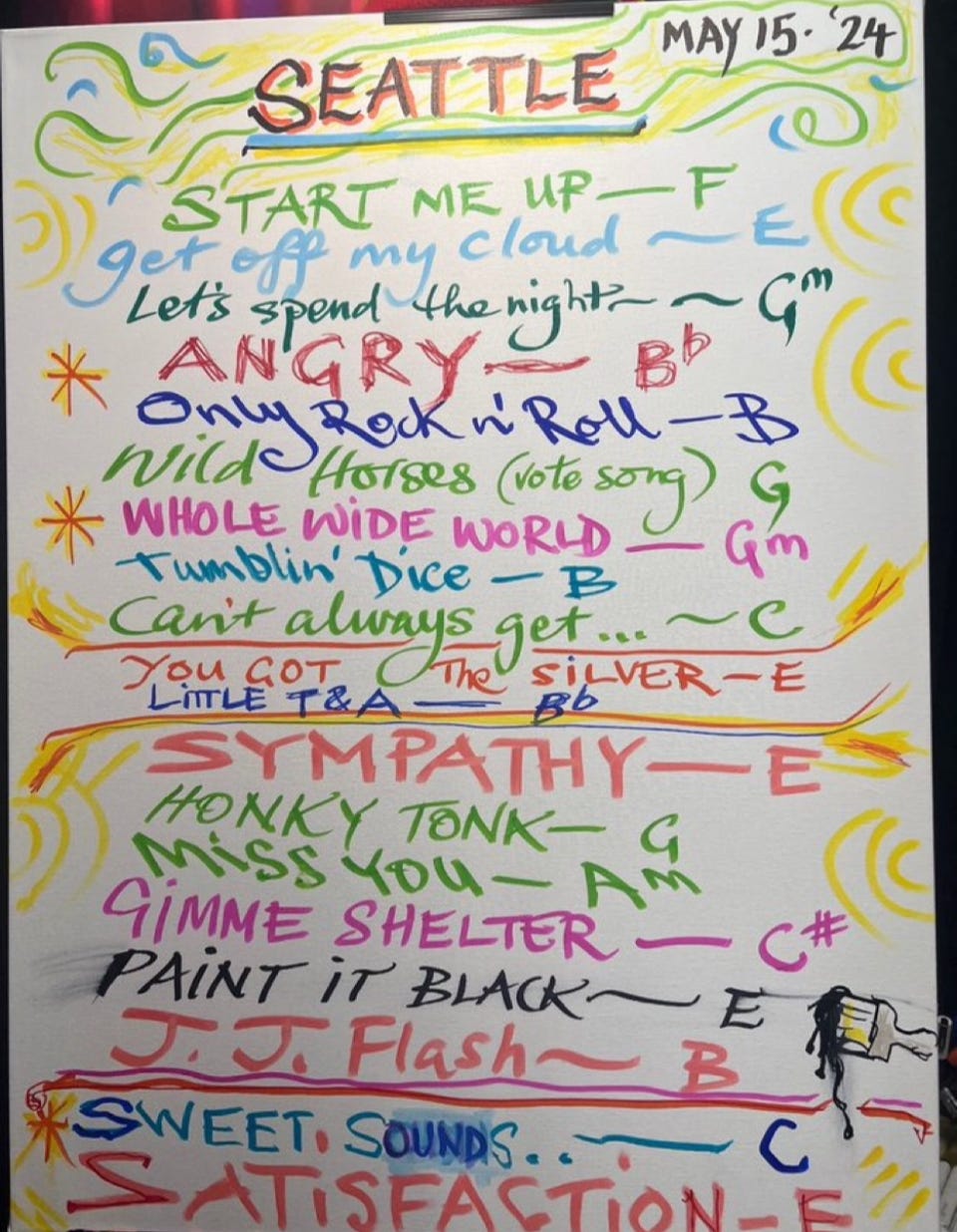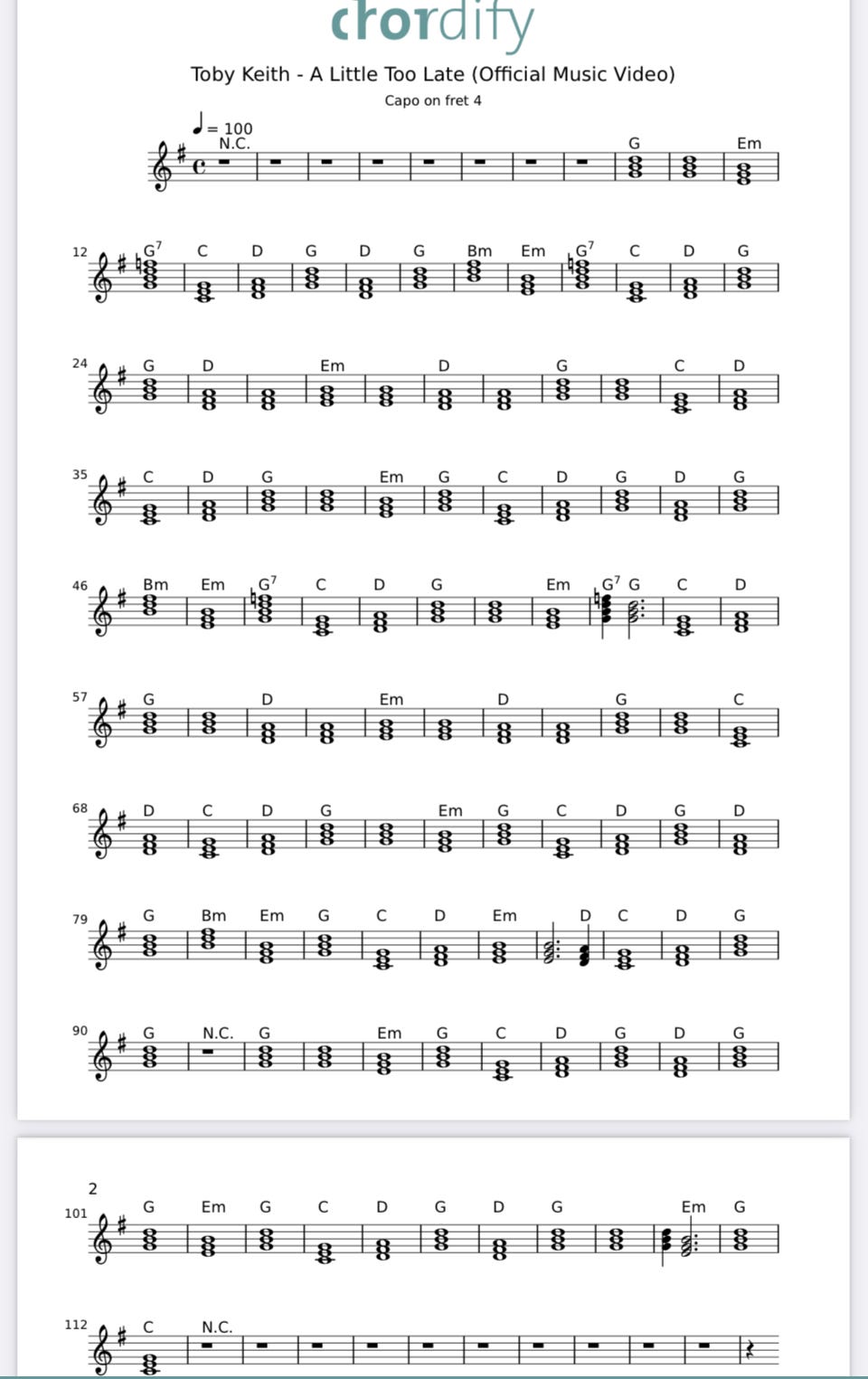Last week’s rando lyrics: The lyric, “A sleepless night, a nervous wreck, a day ago’” is from the song "A Little Too Late”, performed by Toby Keith. Written by Dean Dillon, Toby Keith & Scotty Emerick, it’s Track 2 on the album “White Tra$h With Money", released in April 2006. Produced by Toby Keith & Lari White.
Credit: Genius Link: >A Little Too Late<
From Genius contributor/editor @AlexanderJamesM:
“White Tra$h With Money is the tenth studio album by American country singer-songwriter Toby Keith, released on April 11, 2006, via independent record label Show Dog Nashville. The album marks Keith’s first on a new label after leaving his previous label, DreamWorks Records, and his first with new co-producer Lari White.
A total of three singles were released from the album: “Get Drunk And Be Somebody,” “A Little Too Late” and “Crash Here Tonight.””
Ed. - not gonna lie - I’m missin’ Mr. Keith, a lot. Just as in the video for this song, which is a somewhat downbeat story about an apparently unsalvageable relationship, Mr. Keith’s self-deprecating humor comes through, as he builds a wall that he soon discovers he’s on the wrong side of. A wonderful, talented musician who just didn’t feel a need to publicly take himself too seriously.
Gotta watch till the end…..
(Ed. - Mr. Keith was a prolific songwriter, and one of his co-writers, Mr.Dean Dillon, perhaps lesser known, is just as prolific, writing songs for, and with, many other artists as well as for his own career. You can find his story and how it intertwined with the careers of many other artists in the documentary, “Tennessee Whisky”. I found it on the Plex streaming service, free sign-up, lots of commercials. May be available on other streaming services as well. Thanks, Bob!!)
Welcome to The Regular Friday post!
For Today:
Spring has arrived, or at least made it’s presence known here in the Upper Left Corner of these here contiguous United States. Mowing, sprinklers, more mowing, removing the detritus of last fall, and that sort of thing has been keeping me and all the folks in my neighborhood busy. At least taxes are behind me! So, not a lot to talk about this week from me, haven’t heard anything on the demo, no news is good news, and so here’s some…
…stuff I found on social media:
A couple of weeks ago we talked about the standard tuning frequency of A4 (the “A” note in the 4th octave of an 88 key piano) as 440Hz. Mr Beethoven apparently thought differently…..
Ronnie Wood drew this setlist for the Stones’ Seattle show:
Credit: Twitter (X) repost by @MusicJim2 of Mr. Wood’s original post
And I found this on Twitter (X):
>George and Ringo< - Even if you don’t click any other link on here today (but you should and we both know it) this is just so cool….
A Song To Play…
Original Key of BMaj, 4/4 common time, a little quick at 100 BPM. The capo is on 4 so the song retains the Key of B, but uses the chord shapes of the Key of GMaj - that’s so it’s more available to beginning and early intermediate players - advanced players and pros probably already have Chordify, or can play it by ear. I think using a capo when you’re first starting out (especially) is important because you can hear the end result of your playing without constantly checking your hand position and correct chord shape with barred index finger and such. And after awhile you can get tired of songs only in CMaj or GMaj, maybe an occasional DMaj. Your mileage may vary, but hearing what you can play smoothly is a tremendous incentive to try hearing it smoothly up and down the fretboard. It just takes some time…and nothing breeds success like early success. Also, the number of well known songs on YouTube where an artist is singing while playing a guitar with a capo is pretty large. Doesn’t mean they’re just starting out. On the contrary, playing and singing, especially when being recorded, involves a lot of moving parts - if playing with a capo using cowboy chord shapes lessens the stress a bit, definitely do it.
The thing with using a capo is that it really does retain the intervals of the key the song was originally recorded in. This may have been recorded in BMaj because that fit Mr. Keith’s voice more comfortably than others, maybe by letting him sing in BMaj an octave lower than he otherwise might. The concept of “intervals” is the important part. If you left the capo off and used the above Chordify chord chart, the intervals remain the same, the only thing that changes is the starting point of the calculation of the intervals. The above chart has the same intervals, just starting from the GMaj chord shape. Mr. Keith’s version starts from the BMaj chord, and with the capo on, so does the song above. With the capo off it just starts from GMaj. The experienced session players and Mr Keith could probably just play it starting from BMaj:
which, admittedly, isn’t that difficult. The rest of the song might be though, it’s not like I’m gonna play it in BMaj….
I know that can be a bit difficult to wrap your head around. I think for guitarists it helps to separate the concepts of “chords” from that of “chord shapes”. One way to think of it is how we learn chord “shapes”. The GMaj chord shape is probably one of the first shapes most of us learned - it’s easy. In the common open position (ring, middle, and little finger) shape, the bass note G of the chord is on the third fret of the low E string. So starting from the open E, we count up 1 fret to F, the second fret to F# and put our ring finger on the 3rd fret - the G, which is the bass note of the chord. When the capo is on 4 (G#) it “pushes” our ring finger from G past the G#, then 3 more frets down past the A and A# to the B, and that’s the bass note now, with the capo acting in the same manner as our index finger barred across the 4th fret would. And that results in a BMaj chord, using a GMaj “shape”, with a little help from our friend, the capo...
Lyrics
Credit: Genius Link: Toby Keith, A Little Too Late - A bit unusual leading off with the chorus. My guess, and it’s only that, is that with only one short verse and one slightly longer second verse the song would have been a bit too short for radio play, so the lead off chorus gave a bit more time, and created room for an instrumental break or two. The YouTube video is 4:51, but the song itself is a bit less than 3:30, the rest is pure Toby Keith humor….
[Chorus]
It's a little too late
I'm a little too gone
A little too tired of this hanging on
So I'm letting go while I'm still strong enough to
It's got a little too sad
I'm a little too blue
It's a little too bad
You were too good to be true
I'm big time over you, baby
It's a little too late
[Verse 1]
No, I don't wanna talk about what we can do about us anymore
Only time you and me wasting is the time it takes to walk right out that door
Yeah, talk about water under the bridge
You should know by now, girl, that's all this is
[Chorus]
It's a little too late
I'm a little too gone
A little too tired of just hanging on
I'm letting go while I'm still strong enough to
It's got a little too sad
I'm a little too blue
It's a little too bad
You were too good to be true
I'm big time over you, baby
It's a little too late
[Verse 2]
There was a time this heart of mine
Would take you back every time
Don't you know?
It's been two packs of cigarettes
A sleepless night, a nervous wreck, a day ago
Now you ain't got no business coming around
I'm closing up shop
Shutting us down
[Chorus]
It's a little too late
I'm a little too gone
I'm a little too tired of just hanging on
So I'm letting go while I'm still strong enough to
It's got a little too sad
I'm a little too blue
It's a little too bad
You were too good to be true
I'm big time over you, baby
It's a little too late
I'm big time over you, baby
It's a little too late
The “ME!” Section…..
What I’m Listening2: Link: >Something60ish<
Shameless Self Promotion Section:
My song is out! Link: “Long Road Back”click on link for streaming options, then scroll down for links (or just click on these links) to Amazon, Apple, Pandora, iTunes and even (boo, hiss) Spotify
If you’re enjoying our content, please let your friends and musician acquaintances know about us!!! Thanks for supporting this free newsletter!
Disclaimer Section
This Substack is free, I receive no compensation of any kind from companies or products I mention. Some linked or quoted material may be copyrighted by others, and I credit them. I rely on the “Fair Use” doctrine for educational purposes (Link: Fair Use). *I do not use AI, things I link to might though. -Michael Acoustic
*Exception: For the next few weeks at least I’ll be testing out a beta feature offered on Substack that produces an AI image based on a text input - the image of the week can be seen in the upper left corner of this post…
Thanks for reading! Subscribe for free to receive new posts and support this newsletter.
Some Links For Today
ED. None of these result in compensation to me in any way, and I’m not endorsing any of them, but some of my readers may find them as interesting as I did…
From Blues Guitar Unleashed:
It's A Major Solo - this means a solo in AMaj, not a huge production number. Though soloing, especially with an audience, kinda qualifies no matter what scale/key you’re in.
Many Ways To Solo - here are some of the different ways…..
How to find the "perfects" - the I, IV, and V - This is cool! “Perfects”, by the way are names for some of the “intervals” in a key. The I chord is also known a Perfect Prime of a key, it doesn’t actually have an interval, but it is the starting point for the others. The Perfect Fourth is the interval between the root (Perfect Prime) and the IV chord in a Major Key (Minor Keys also have perfect intervals, just from a different starting point). The Perfect Fifth is the interval between the root and the V chord, and the Perfect Octave is the interval between the root and the next highest incidence of the root note of the scale that the key is based on. The ii-, iii-, vi- and vii(dim) aren’t perfect intervals because each of the minors contain a minor interval and the vii(dim) contains a minor and diminished interval. Confused yet? This link may help. Or not. Difference Between Minor And Diminished Intervals)
From Acoustic Guitar Magazine:
"Hello In There" by John Prine - John Prine is a treasure taken from us too soon. Here’s how to play one of his great songs.
From American Songwriter Magazine:
Vince Gill Reveals "Best Guitar Player Ever" You’ll never guess…..
From Songtown:
Lyric Pitfalls - A “pitfall” is a well disguised trap. Lyric pitfalls are traps you create for yourself in songwriting and then, of course, fall into them. Here’s a way to avoid such silliness. Mere repetition may or may not be a lyric pitfall. Note how many times Mr. Keith repeats the phrase “a little too” in the song above and avoids the trap by following the phrase with a word that gives a different meaning each time.
What's Stopping You? Poignant story with a point - I couldn’t find where the song was ever recorded, but this is worth the read.
A Day Of Practice - Never let the bastards wear you down….
From the Disc Makers Blog:
What Is "Remastering"? - Bet you’d like to know, wouldn’t you? I know, cuz I read the article. You should too.
Sequencing An Album - Should there be a pattern or meaning to the order of songs on an album? Find out here….
How To Get On Billboard Charts - Indie artists can go downtown, too. Or uptown. Wherever Billboard charts take you…
Thank You To Our New Subscribers and Followers!! This Week’s Conversation With Mika, the Cat:
Me: “Is this because we watched that ‘Meerkat Manor’ show the other night….?”
Mika : “Shut up…”
Cheers and keep playing!!
Michael Acoustic
“It’s never really final - you just run out of things you can bear to change…”










Love the Toby Keith vid! I enjoy artists who "play with the construct," namely things like crouching to fit into camera frame! Not to mention, of course, the storyline of the thing....which, I'm hoping was his idea to begin with! I think you've got ME missing him, now, after only just being aware of his existence before!
That George and Ringo clip was very cool. Great to see them working together without caring a whit about publishing/credit percentage! The "HarriStarr" songwriting pair was, apparently, under-utilized!
Cool setlist art by Wood, too....I've seen a few setlists, but don't recall key reminders on them. Nice touch, and, I'm guessing, necessary (at least by 80-year-olds?)! How common/frequent is that, in general? I'd guess, also, that a younger band may not need it, but regardless of age, if a band has players/guest players who might be new to the show, that would be a helpful conceit for them!
Lots of stuff here for ME! Thanks, Michael!
Love it. Tuning forks! What’s more or less the mid-point between 423.5 and 455.4? Let me see, that would be roughly… 440… I know let’s standardise it there, in the middle… you know, like an average… then everyone will be happy, right? (Wrong! 😂)